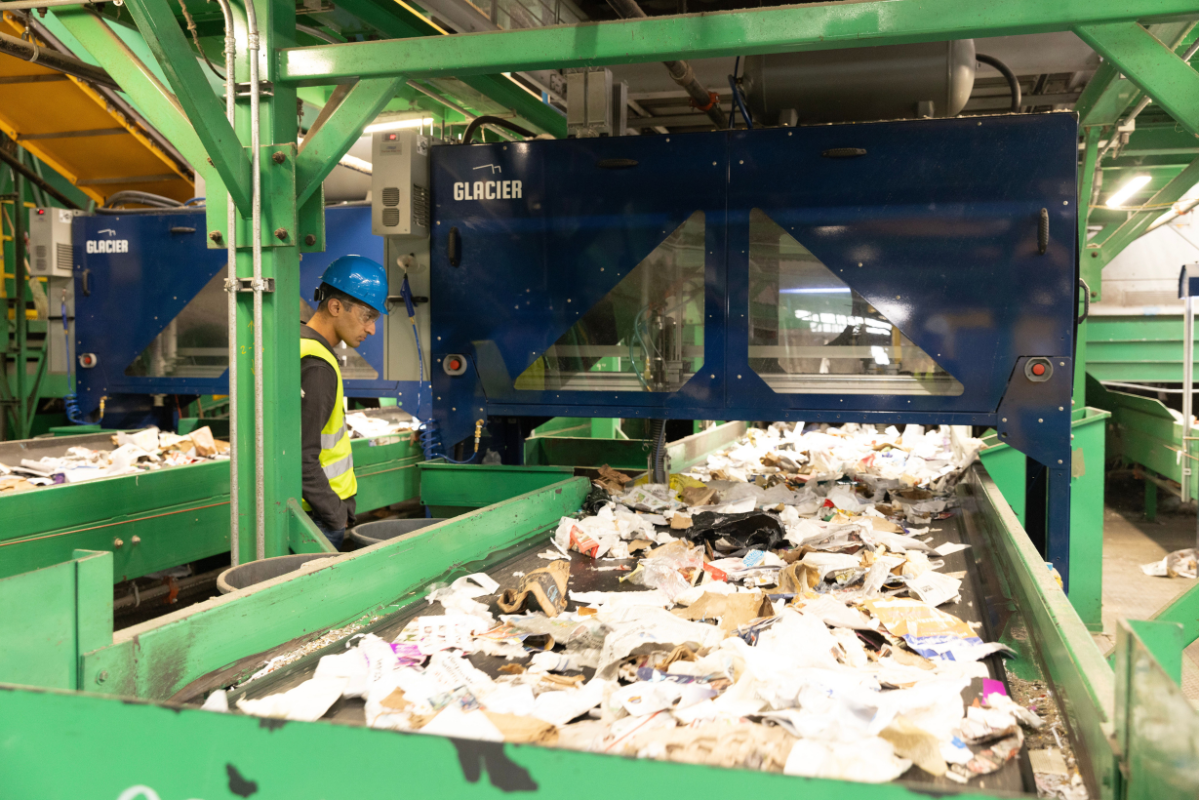
Robotics from Glacier might be made to suit any belt width and might goal greater than 30 distinct supplies. | Courtesy of Glacier
The co-founders of rising sortation robotics provider Glacier say their robots present a right away high quality profit with a small footprint: They are often positioned wherever a guide sorter could be stationed.
Based in 2019, tech startup Glacier on March 6 announced it acquired $7.7 million from New Enterprise Associates (NEA) and Amazon’s Local weather Pledge Fund, an funding arm of the e-commerce big. Glacier is an rising participant within the MRF robotics business, and its newest funding brings the corporate’s complete capital raised to $13 million to this point since its launch.
In outlining its funding, Amazon wrote that Glacier’s know-how “might help enhance the standard of recycled content material in order that extra post-consumer materials is out there to be used in new packaging. Long run, it could possibly additionally allow recycling for extra varieties of packaging and supplies than usually are not at the moment recycled.”
With a employees of twenty-two, the gear provider is predicated in San Francisco, the place it additionally designs and assembles and assessments its robotic techniques. Glacier moreover works with a handful of contract producers, who do duties like welding frames and constructing motors inside the robots. The corporate is at the moment working with about two dozen prospects throughout 10 states, lots of that are recycling services.
Useful resource Recycling spoke with Glacier co-founders Rebecca Hu and Areeb Malik to study extra about their compact robotic techniques and why they’re drawing funding consideration.
Spurred by market strife
Each co-founders have backgrounds working within the tech area, and once they met, each have been desirous to work extra particularly on sustainability-focused ventures. They narrowed in on the recycling sector and started creating gear for the sortation discipline, pushed by just a few observations.
The staff noticed alternatives in each buyer demand and technological development. It was 2019, and the recycling business was struggling within the wake of China’s pullback from the export market. High quality was key: MRF operators wanted to cut back contamination and to do it shortly. In lots of methods, Glacier launched due to the alternatives created by China’s Nationwide Sword marketing campaign, Hu says.
“This business that has carried out issues a sure manner for a lot of many years, is definitely at a second when everybody is basically excited to see what’s on the market and discover new know-how,” she mentioned.
Moreover, the market challenges lined up with development in synthetic intelligence (AI) capabilities, to the purpose that Malik and Hu decided they may have a considerable and instant impression in that a part of the business by utilizing rising know-how. There was a transparent alternative to take AI and robotics and “begin making use of it to the sortation problem,” Malik mentioned.
Hu added that working to boost the skills of the present MRF infrastructure was an accessible option to shortly bolster the recycling system, versus shifting upstream to sort out shopper recycling habits, for instance.
“The immediacy of the potential impression was actually interesting,” Hu mentioned.
Compact robots permit for fast increase
Glacier’s curiosity in instant enchancment additionally performed into the selection to produce robots, versus different sorting applied sciences. Malik famous that optical sorters are a robust know-how, however that they’ll usually require a full MRF retrofit to put in. The robots Glacier provides, alternatively, might be dropped onto a top quality management line with out substantial facility adjustments.
“Anywhere in your facility that you’ve got a sorting station, our robotic can go in and supply that further sorting energy,” Malik mentioned.
The corporate’s robots might be put in on conveyor belts of any width, Hu added, avoiding the necessity to double up with two robots to accommodate wider belts, as an illustration.
Glacier’s robots carry out a mean of 45 picks per minute, a metric the corporate calculates from models put in inside MRFs. However Hu defined that metric might be extra difficult than it sounds: Generally it’s reported as hypothetical picks per minute in a lab, generally it refers to what number of instances a robotic arm makes an attempt to seize a chunk of fabric off the belt. She famous that for MRF operators, the one factor that issues is the bodily variety of gadgets the robotic accurately places in its correct location.
Hu added that though picks per minute is a vital metric, she recommends MRF operators take into account what they actually need the robotic to do, particularly what number of picks they really want the robotic to carry out.
Finally, she proposed a pair variations on the metric: picks per minute per greenback spent and picks per minute per sq. foot the gear occupies. These concerns might help guarantee a MRF installs the correct system for its precise wants.
Glacier’s knowledge analytics system is an equally necessary part of what the corporate gives. In reality, Hu says the staff at one time thought-about focusing totally on the AI system quite than robotics, however determined they wished to additionally present the instrument (robotics) to place the AI knowledge into motion.
In addition to enabling a basic enlargement of the corporate, Glacier’s current funding will support in increase the information analytics and materials identification capabilities. It at the moment identifies 30-plus supplies, together with fiber, PET, HDPE, black plastic, thermoforms, aluminum, aseptic containers and extra.
“We wish to proceed to increase that listing very thoughtfully,” Hu mentioned.
A model of this story appeared in Resource Recycling on Mar. 12.


